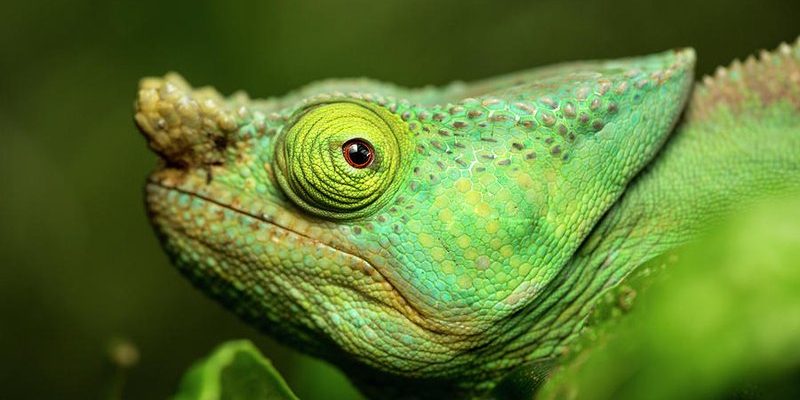
Let’s dive into the world of the Parson’s Chameleon. Imagine you’re at a café, sipping coffee, and someone asks, “Are these reptiles friendly companions or just little tyrants in disguise?” That’s exactly what we’ll explore today. We’ll take a closer look at their behavior, their natural instincts, and even how to care for one if you decide to adopt this unique reptile.
Understanding the Parson’s Chameleon’s Behavior
To figure out if the Parson’s Chameleon is aggressive or friendly, we first need to look at its natural behavior. In the wild, these chameleons are solitary creatures, often found lounging in trees or shrubs in Madagascar. They like to keep to themselves, which can sometimes be misinterpreted as aggression. However, this doesn’t necessarily mean they’re unfriendly.
When feeling threatened, a Parson’s Chameleon might puff up its body, display bright colors, or even hiss to ward off perceived danger. This behavior is more about survival instincts than actual aggression. Here’s the thing: these chameleons don’t seek out confrontation. They just prefer to express themselves through colors and behavioral displays. So, if you see one acting defensively, it’s likely just trying to say, “Back off, I’m not a threat, but don’t mess with me!”
Color Changes and Their Meanings
Color changes in chameleons go beyond just looking pretty; they serve as a form of communication. A Parson’s Chameleon might change colors based on its emotional state. Here are some common colors and their meanings:
- Bright Greens: Content and relaxed.
- Dark Colors: Feeling threatened or stressed.
- Vibrant Blues or Yellows: Attracting a mate or showing off.
So, if you notice your chameleon turning dark, it might just be feeling a bit anxious. Understanding these signals can help you interact more effectively and minimize stress for both you and your chameleon.
Are They Aggressive Toward Humans?
Now, let’s address the big question: how do Parson’s Chameleons react to human interaction? Generally, they aren’t known to be aggressive toward humans. Unlike some reptiles that may bite when scared, Parson’s Chameleons usually prefer to retreat into their surroundings rather than confront threats directly. They’re not eager to attack; they just want to blend in and be left alone.
Of course, that doesn’t mean they don’t have their limits. If they feel cornered or mishandled, they may hiss or try to escape. If you’re planning to handle one, it’s important to approach calmly and allow them to acclimate to your presence. Think of it like trying to befriend a shy dog; patience is key. By establishing trust, you can help your chameleon feel safe and secure.
Socialization and Handling Tips
If you’re considering keeping a Parson’s Chameleon as a pet, socialization is crucial. These animals might not be as cuddly as a cat or dog, but you can still build a positive relationship with them. Here are some tips for socializing your chameleon:
1. Start Slowly: Begin by spending time simply observing your chameleon in its habitat. Don’t rush to handle it right away.
2. Use Positive Reinforcement: If you must handle your chameleon, do so gently, and reward it with a favorite treat afterward. This can help build a positive association with being held.
3. Create a Comfortable Environment: Make sure their enclosure mimics their natural habitat with plenty of branches and foliage. A happy chameleon is less likely to act defensively.
By following these steps, you’ll create a more trusting bond, allowing both you and your chameleon to enjoy each other’s company without stress.
Can They Get Along With Other Pets?
If you have other pets at home, you might be wondering if a Parson’s Chameleon can fit into the mix. While some reptiles can coexist peacefully with other animals, Parson’s Chameleons are best kept alone or with other reptiles of similar size and temperament. They are solitary by nature and generally don’t appreciate the presence of other active pets.
Imagine inviting a quiet friend over for coffee, only to have a loud party taking place next door. It’s distracting! Similarly, a chameleon might feel stressed if there are rambunctious cats or dogs flying around. The safest bet is to keep your chameleon in a dedicated space where it can feel secure and undisturbed.
Final Thoughts on Parson’s Chameleon Personality
So, after exploring their behavior, socialization tips, and interactions with humans and other pets, what do we conclude about the Parson’s Chameleon? Overall, they lean more towards being non-aggressive than friendly companion animals. They’re not seeking conflict, but they also value their space and don’t take kindly to feeling threatened.
If you’re considering adding one to your family, remember to approach them with patience, create a comfortable habitat, and give them the respect they deserve. With the right care and environment, you may just find that this vibrant chameleon has a charming personality waiting to shine—just on its own terms. Whether it’s watching their color displays or simply enjoying their unique presence, the journey of being a Parson’s Chameleon owner can be quite rewarding.

